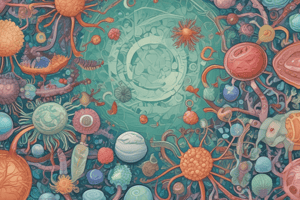Podcast
Questions and Answers
Which protein is a component of prokaryotic flagella?
Which protein is a component of prokaryotic flagella?
- Tubulin
- Actin
- Flagellin (correct)
- Kinesin
Which of the following statements about prokaryotic cells is correct?
Which of the following statements about prokaryotic cells is correct?
- Their DNA is linear and associated with histone proteins.
- They have a nucleus with a nuclear membrane.
- They contain 70S ribosomes. (correct)
- They have Golgi bodies and endoplasmic reticulum.
What is the function of the Svedbergs unit (S) in the context of ribosomes?
What is the function of the Svedbergs unit (S) in the context of ribosomes?
- It indicates the density gradient during centrifugation. (correct)
- It measures the surface area of ribosomes.
- It calculates the ribosomal RNA content.
- It specifies the volume of ribosomes.
Which organism uses pseudopodia for locomotion?
Which organism uses pseudopodia for locomotion?
Which type of ribosome is found in prokaryotic cells?
Which type of ribosome is found in prokaryotic cells?
What is a distinctive feature of the lysosomes in plant cells?
What is a distinctive feature of the lysosomes in plant cells?
Which organelle is described as having a 9+2 arrangement of microtubules?
Which organelle is described as having a 9+2 arrangement of microtubules?
What is the primary substance constituting the cell wall of plant cells?
What is the primary substance constituting the cell wall of plant cells?
What is the main difference in the development of the Golgi complex between plant and animal cells?
What is the main difference in the development of the Golgi complex between plant and animal cells?
Which characteristic is specific to sap vacuoles in plant cells?
Which characteristic is specific to sap vacuoles in plant cells?
Flashcards are hidden until you start studying
Study Notes
Prokaryotic Cell
- A primitive karyon is present, but it lacks a nucleus with a nuclear membrane.
- The DNA in prokaryotic cells is circular and naked, meaning it's not bounded by a nuclear membrane.
- Histone proteins are present, but they do not form a nucleus.
- Membrane-bound organelles such as Golgi, ER, and Lysosomes are absent.
Cell Components
- Ribosomes, the protein factories, are 70S in prokaryotes.
- The S in 70S refers to the Svedberg unit, a measure of the size and shape of the ribosome.
Locomotion
- Prokaryotic cells move using flagella, which are made of the protein flagellin.
- Flagella are also found in some eukaryotes, such as Euglena, Chlamydomonas, and higher animals.
- Amoeba, on the other hand, forms pseudopodia to move.
Eukaryotic Flagella
- Characterized by a 9+2 arrangement of microtubules composed of tubulin
Plant Cell
- Has a cell wall made of cellulose
- Green cells possess chloroplasts or other types of plastids
- Contains a large, central sap vacuole that stores water and salts
- Possesses lysosomes that can break down and destroy worn-out organelles
- Has a well-developed Golgi complex, also known as dictyosomes
- Contains centrioles, which are also found in flagella
Animal Cell
- Has a peripheral and smaller sap vacuole compared to plant cells
Studying That Suits You
Use AI to generate personalized quizzes and flashcards to suit your learning preferences.




